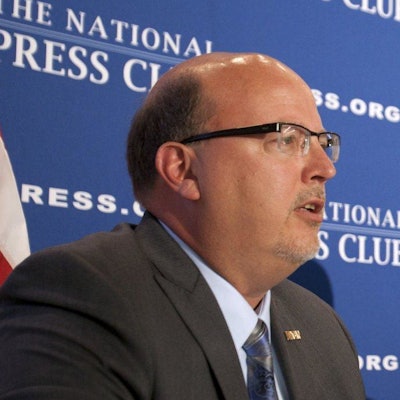
The counterfeiting of well-known brands and products is a problem that continues to rise each year and is currently estimated to make up five to seven percent of world trade, or $1.77 trillion in 2015. Counterfeited brands, including consumer safety, manufacturing and electrical products, can have threatening implications for industry workers and facilities alike.
These unsafe lookalike devices use, without authorization, the trademark, service mark or copyright of another with the intention of deceiving prospective customers into believing that the product is genuine. Even the trusted marks of independent certifications have been counterfeited. Manufacturers of these counterfeit products rely on deception, the Internet and prices below market-level to get these products into homes, businesses, and commercial and industrial manufacturing facilities.
The Financial Toll of Counterfeiting
The International Anti-Counterfeiting Coalition (IACC) has estimated that the counterfeiting of distinguished brands cost industries in the U.S. $250 billion each year, and may also result in as many as 750,000 lost jobs annually.
In 2013 alone, there were 24,361 seizures of counterfeit products valued at more than $1.7 billion (MSRP) by U.S. Customs and Border Protection. Over the last five years, counterfeit seizures have seen nearly 50 percent annual growth.
While the economic consequences of counterfeiting are more than alarming, professionals in the electrical and manufacturing industries must also recognize the health and safety risks that these counterfeit electrical products present.
The Dangers of Counterfeiting
Counterfeit electrical products pose very serious threats to the safety of workers and work environments within the electrical and manufacturing industries. Suspect products, such as circuit breakers, ground fault and arc-fault interrupters and surge protectors, are often made without regard for electrical safety or failing to meet minimal performance specifications.
As a result, using counterfeit products can lead to a high risk for failure or malfunction. These failures can cause electric shock, overheating or short circuits, often leading to equipment failure, fires, or explosions that can potentially cost workers their lives and cause substantial property damage to facilities.
In fact, the National Fire Protection Association (NFPA) has reported that electrical failure or malfunction was responsible for 47,700 home structure fires and 16,400 non-home structure fires in 2011 alone.
What Professionals Know About Counterfeiting
Most industry professionals would agree that detecting the difference between a genuine or a fake product becomes more difficult as counterfeiters gain more and more sophisticated practices.
In an attempt to emphasize the difficulty in recognizing a counterfeit by appearance alone, Eaton has shown numerous facility managers, authorized distributors, independent electrical resellers and electrical contractors seemingly identical circuit breakers with one major difference — one is counterfeit — and asked them to point out the fake. After inspecting the products carefully, each professional comes to the same realization, “I never would have thought it to be counterfeit — I didn’t know.”
While it is challenging to identify the difference between a counterfeit product and an authentic one, industry professionals are moving in the right direction when it comes to recognizing and understanding the dangers of counterfeits, and industry survey results are proving this trend.
To identify what professionals know about counterfeit electrical products, Eaton teamed up with the Independent Electrical Contractors (IEC) to survey IEC members on their knowledge of the dangers of counterfeit products.
Survey results concluded that educational campaigns are driving an increase in awareness of the dangers of counterfeit products and are providing the necessary tools needed to make informed purchasing decisions, thus increasing electrical safety overall. Participating IEC members understand the potential safety hazards of counterfeit products, the increasing sophistication of counterfeiters, and how to avoid such products by purchasing directly from the manufacturer’s authorized distributors or resellers.
However, the survey also revealed that there is more work to be done to inform professionals across industries on how to stay protected from electrical product counterfeiting.
Continued education is necessary to raise awareness among those who could potentially come in contact with a counterfeit. It is crucial to work together to prevent these unsafe products from causing harm to people and property.
How Professionals Can Protect Themselves Against Counterfeits
To protect themselves from counterfeit electrical products and help combat this industry-wide problem, electrical and manufacturing industry professionals can utilize the following anti-counterfeiting practices to build confidence in their ability to properly avoid, identify and report counterfeits.
1. Know counterfeits are hard to spot.
Because counterfeiters are becoming increasingly sophisticated, counterfeit products are becoming more difficult to spot in the field or while purchasing.
The best way to avoid counterfeit electrical products is to purchase products from the manufacturer’s authorized distributors or resellers. There is a higher risk of counterfeits if one cannot trace the path of commerce to the original manufacturer.
2. Know your resources.
Take advantage of the resources available for staying protected against counterfeiting. Many companies and organizations are leading efforts to protect their customers by providing tools, tips and information to help avoid customers from coming into contact with potentially dangerous electrical devices. For instance, Eaton’s Circuit Breaker Authentication (CBA) tool allows customers to detect if Eaton’s molded case circuit breakers (MCCBs), up to 400 amperes, are counterfeit.
3. Know how to report a counterfeit.
If you encounter a counterfeit in the field, report it to the brand owner. This will allow authentication of the suspect product and ensure that it is removed from the marketplace. Contact Eaton at [email protected].
If you cannot find brand contact information, do not stop there. Be sure to contact the IPR Center who will disseminate the information for appropriate response. Contact the IPR Center at [email protected] or 1-866-IPR-2060.
4. Know that you can help.
If everyone played an active role in stopping counterfeit products from being bought and sold, the demand for counterfeit electrical products would decrease. Reducing the spread of counterfeit electrical products can help to maximize electrical safety protection.
For more information about counterfeit electrical products, visit www.eaton.com/counterfeit.
Tom Grace is a brand protection manager for Eaton’s Electrical Sector.





















